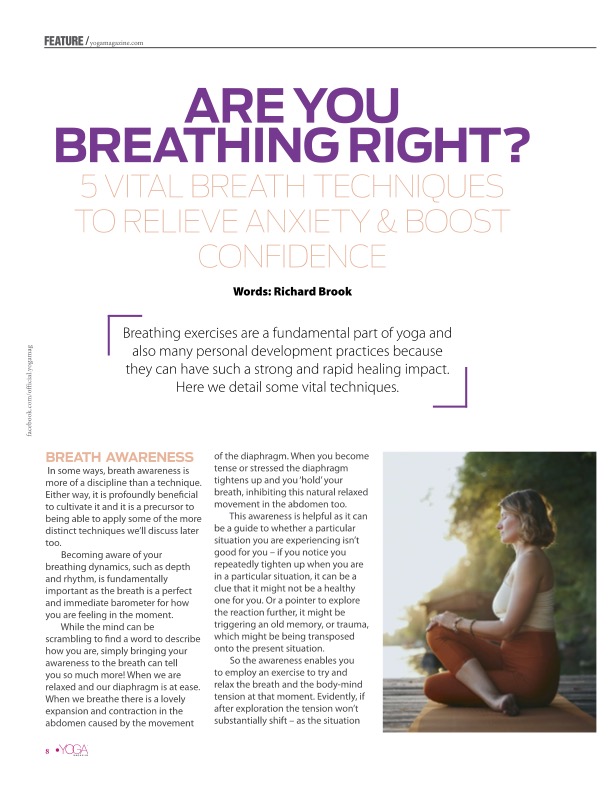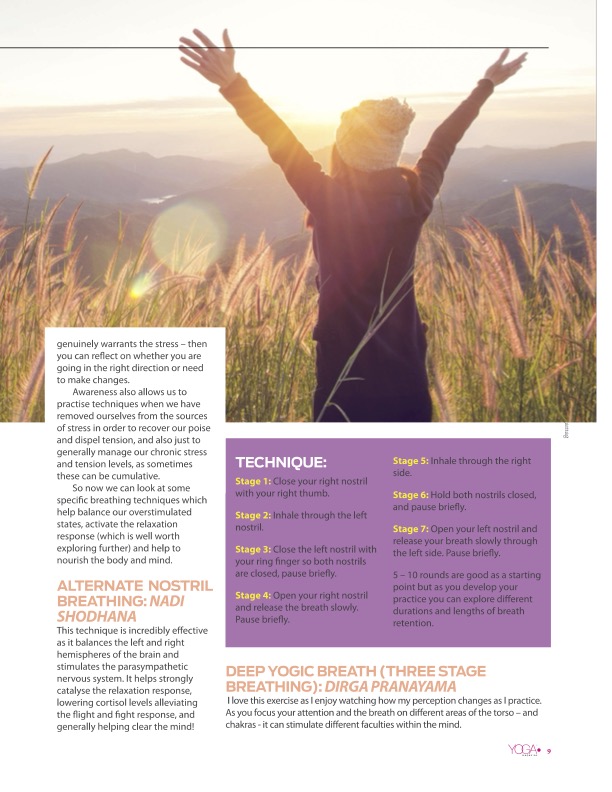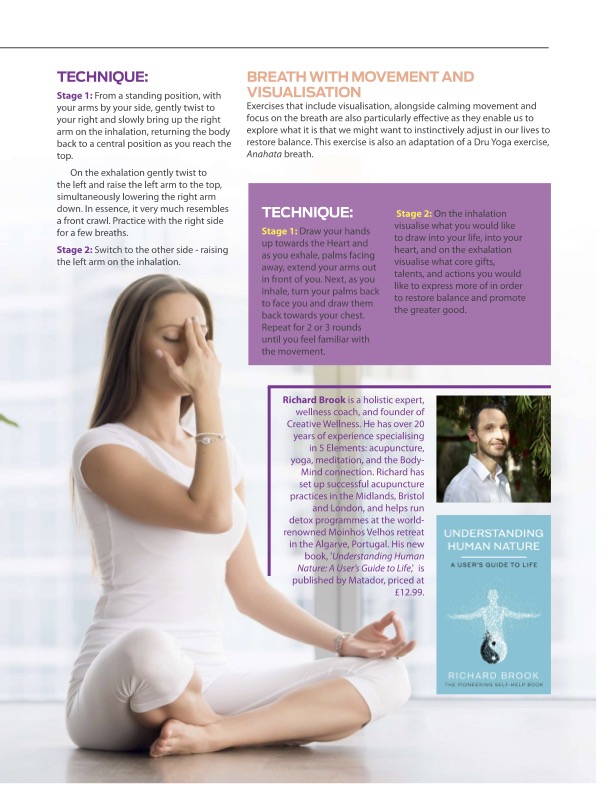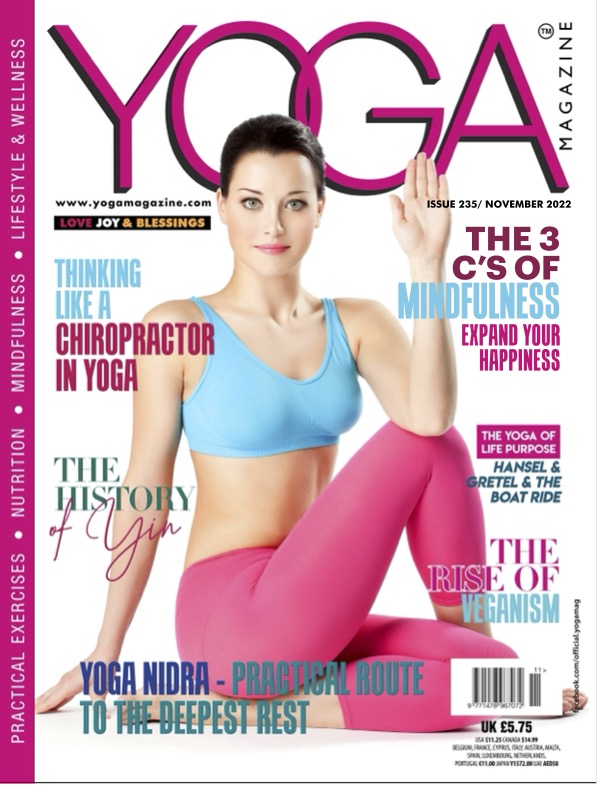Breathing exercises are a fundamental part of yoga and also many personal development practices because they can have such a strong and rapid healing impact. Here Richard details 5 vital techniques.
Breath Awareness
In some ways breath awareness is more a discipline than a technique but it is profoundly beneficial to cultivate it, and is a precursor to being able to apply some of the more distinct techniques we’ll discuss later too.
Becoming aware of your breathing dynamics, such as depth and rhythm, is fundamentally important as the breath is a perfect and immediate barometer for how you are feeling in the moment.
While the mind can be scrambling to find a word to describe how you are, simply bringing your awareness to the breath can tell you so much more! When we are relaxed and our diaphragm is at ease, when we breath there is a lovely expansion and contraction in the abdomen caused by the movement of the diaphragm. When you become tense or stressed the diaphragm tightens up and you ‘hold’ your breath, inhibiting this natural relaxed movement in the abdomen too.
So this awareness is helpful as it can be a guide to whether a particular situation you are experiencing isn’t good for you – if you notice you repeatedly tighten up when you are in a particular situation it can be a clue it might not be a healthy one for you. Or a pointer to explore the reaction further, it might be triggering an old memory, or trauma, which might be being transposed onto the present situation.
So the awareness enables you to employ an exercise to try and relax the breath and the body-mind tension in that moment. Evidently, if after exploration the tension won’t substantially shift – as the situation genuinely warrants the stress – then you can reflect whether you are going in the right direction or need to make changes.
Awareness also allows us to practise techniques when we have removed ourself from the sources of stress in order to recover our poise and dispel tension, and also just to generally manage our chronic stress and tension levels, as sometimes these can be cumulative.
So now we can look at some specific breathing techniques which help balance our overstimulated states, activate the relaxation response (which is well worth exploring further) and help to nourish the body and mind.
Alternate Nostril Breathing: Nadi Shodhana
This technique is incredibly effective as it balances the left and right hemispheres of the brain and stimulates the parasympathetic nervous system. It helps strongly catalyse the relaxation response, lowering cortisol levels alleviating the flight and fight response and generally helping clear the mind!
Technique
Close your right nostril with your right thumb.
Inhale through the left nostril.
Close the left nostril with your ring finger so both nostrils are closed, pause briefly.
Open your right nostril and release the breath slowly. Pause briefly.
Inhale through the right side.
Hold both nostrils closed, pause briefly.
Open your left nostril and release breath slowly through the left side. Pause briefly.
5 – 10 rounds are good as a starting point but as you develop your practice you can explore different durations and lengths of breath retention.
Deep Yogic Breath (three stage breathing): Dirga Pranayama
I love this exercise as I enjoy watching how my perception changes as I practice. As you focus your attention and the breath on different areas of the torso – and chakras - it can stimulate different faculties within the mind.
Technique:
Tip: Placing your hands on the relevant part of the torso can aid focus and effectiveness.
Stage 1: Focus on deepening the breath down into the belly, using the comforting sensation of the hands resting there to assist, breathing into this lower area connects you to the sensation of you roots and ground underneath you.
Stage 2: Continue the inhalation so the breath also starts to expand under the rib cage, which helps connect you to the awareness of what’s around you.
Stage 3: Continue the inhalation so you also expand the breath underneath the collarbones, which helps connect you to the sense of space above you and the more subtle aspects of your being.
So we end up with a full spectrum breath that connects us to our roots, enables us to open to what’s around us and connects us to a sense of space and inspiration.
Breath with gentle movement
When the nervous system is overstimulated and the mind jumpy, it can be challenging to sit still and focus on the breath, so movement and breath combined together can bring a nice gradual slowing down! You’ll find many sequences in yoga where you move the whole body in relation to the breath, but not so many where you move limbs in a repetitive flowing way, similar to Qi Gong exercises. But they do exist, such as with this Dru Yoga exercise, Windmill Breath.
Technique:
Stage 1: From a standing position, with your arms by your side, gently twist to your right and slowly bring up the right arm on the inhalation, returning the body back to a central position as you reach the top.
On the exhalation gently twist to the left and raise the left arm to the top, simultaneously lowering the right arm down. In essence it very much resembles a front crawl. Practice with the right side for a few breaths.
Stage 2:
Switch to the other side - raising the left arm on the inhalation.
Breath with movement and visualisation
Exercises that include visualisation, alongside the calming movement and focus on the breath are also particularly effective as they enable us to explore what it is that we might want to instinctively adjust in our lives to restore balance. This exercise is also an adaptation from a Dru Yoga exercise, Anahata breath.
Technique:
Stage 1
Draw your hands up towards the Heart and as you exhale, palms facing away, extend your arms out in front of you. Next, as you inhale, turn your palms back to face you and draw them back towards your chest. Repeat for 2 or 3 rounds until you feel familiar with the movement.
Stage 2
On the inhalation visualise what you would like to draw into your life, into your heart, and on the exhalation visualise what core gifts, talents and actions you would like to express more of in order to restore balance and promote the greater good.
Richard Brook is a facilitator at Moinhos Velhos, holistic expert and founder of Creative Wellness. His new book, Understanding Human Nature: A User’s Guide to Life, is published by Matador, priced at £12.99.





For more information please feel free to visit Richard's site, or of course book on a programme and come and meet him in person!

